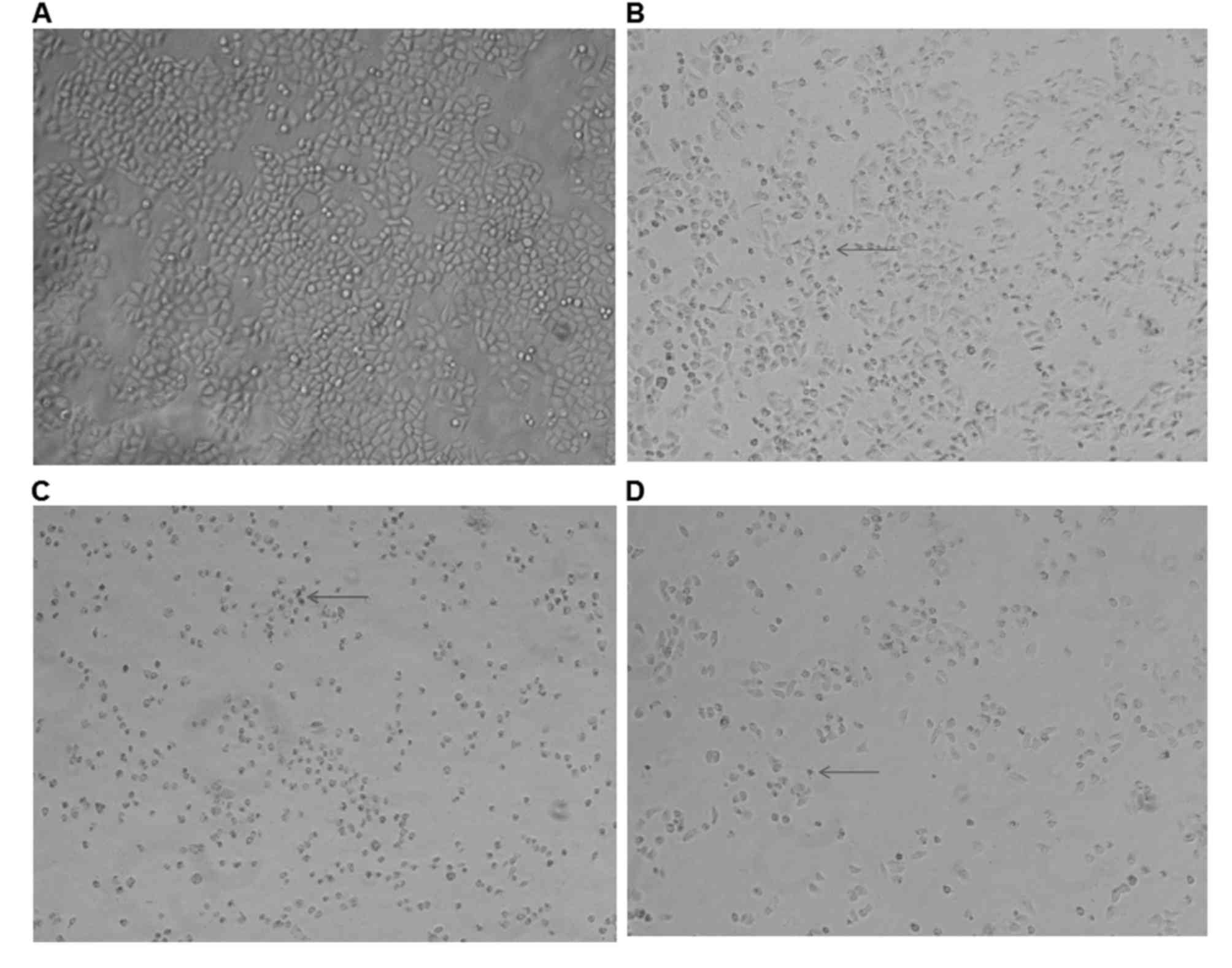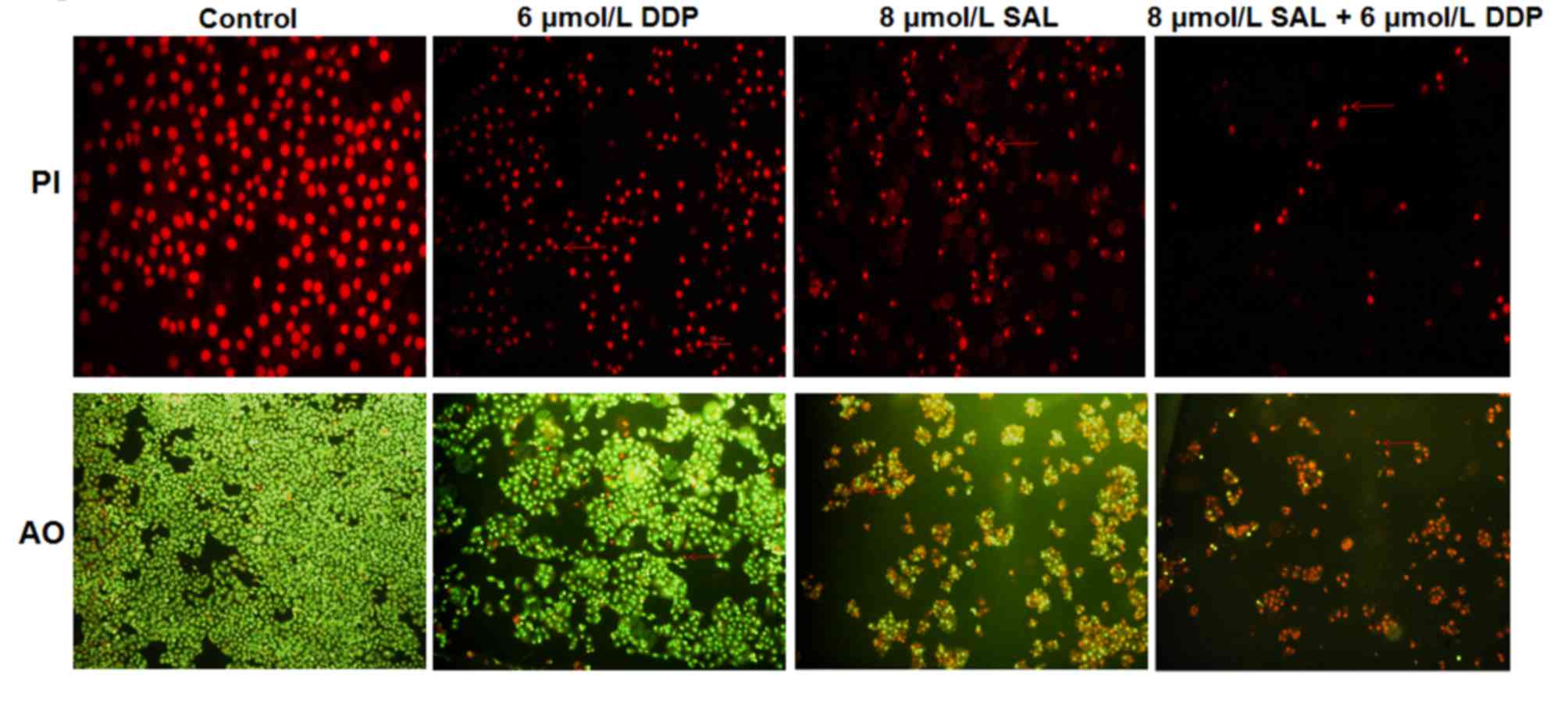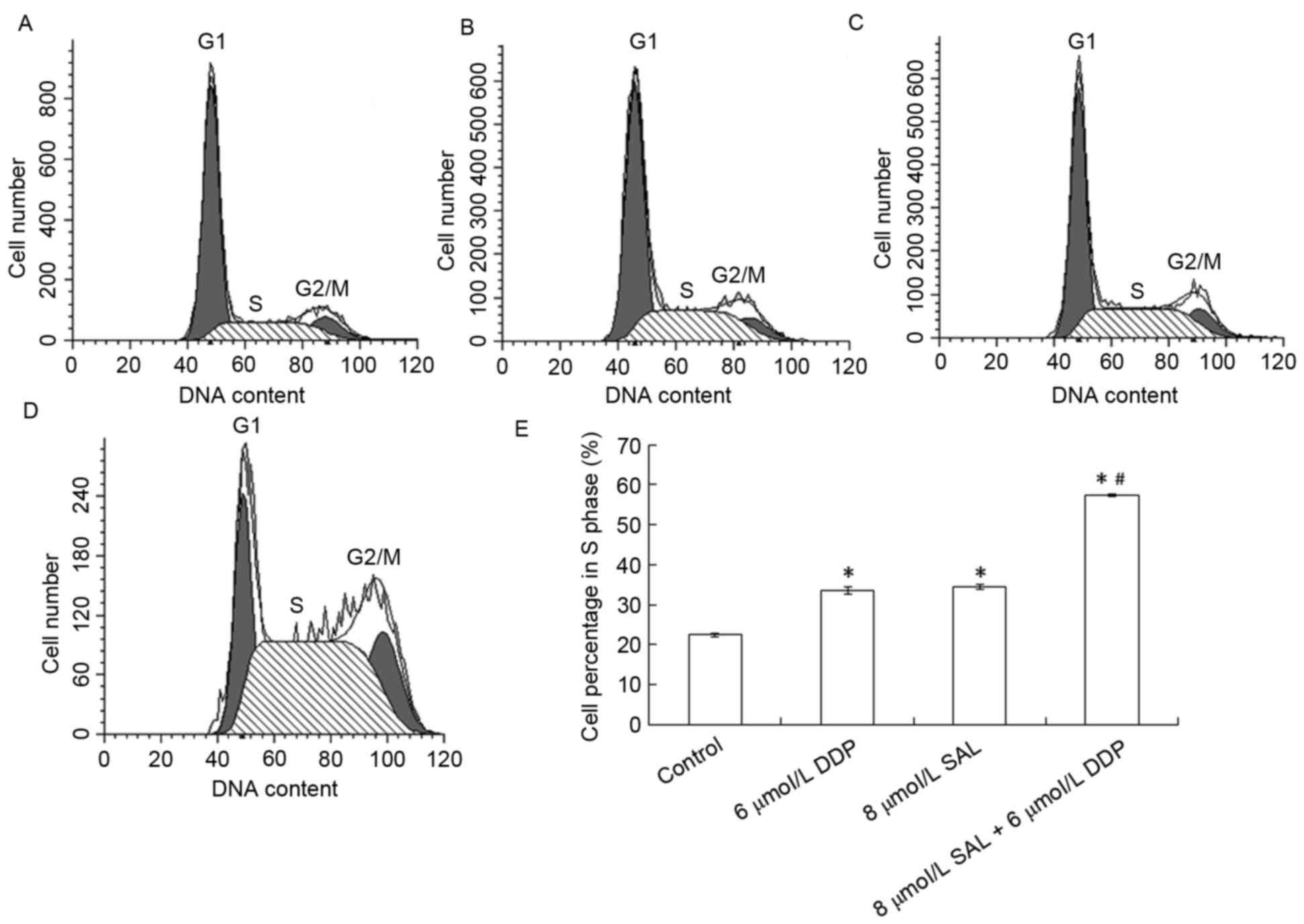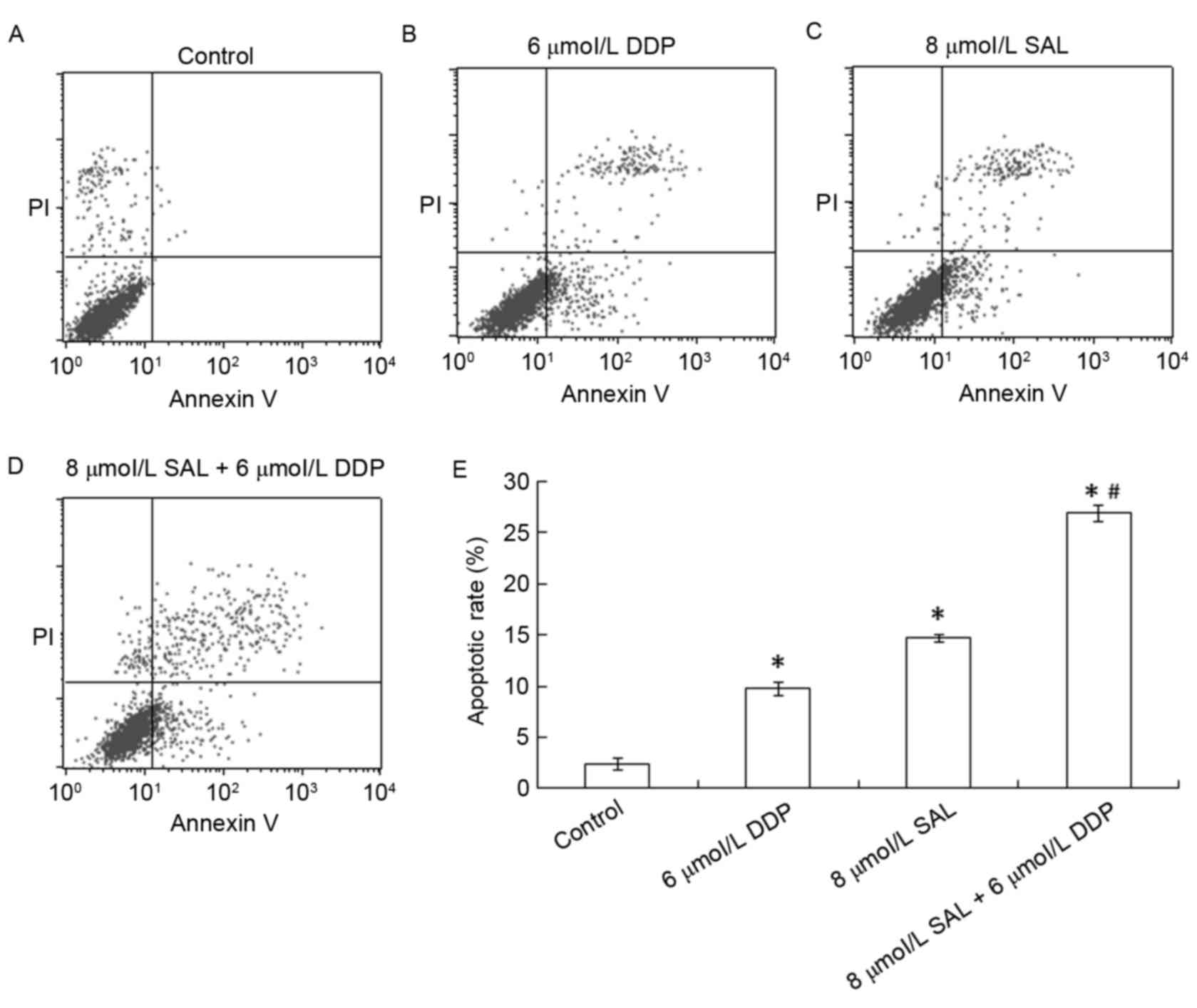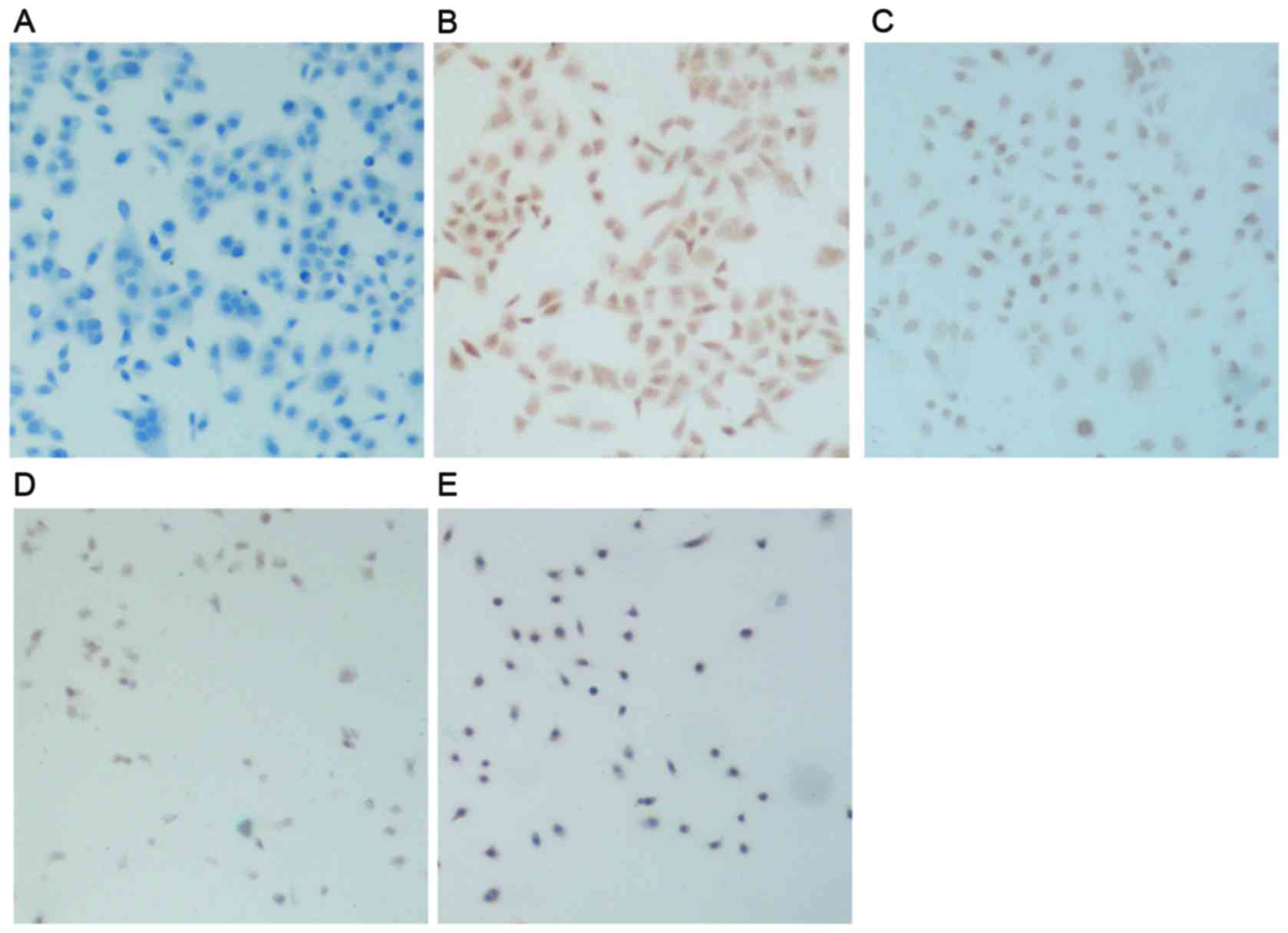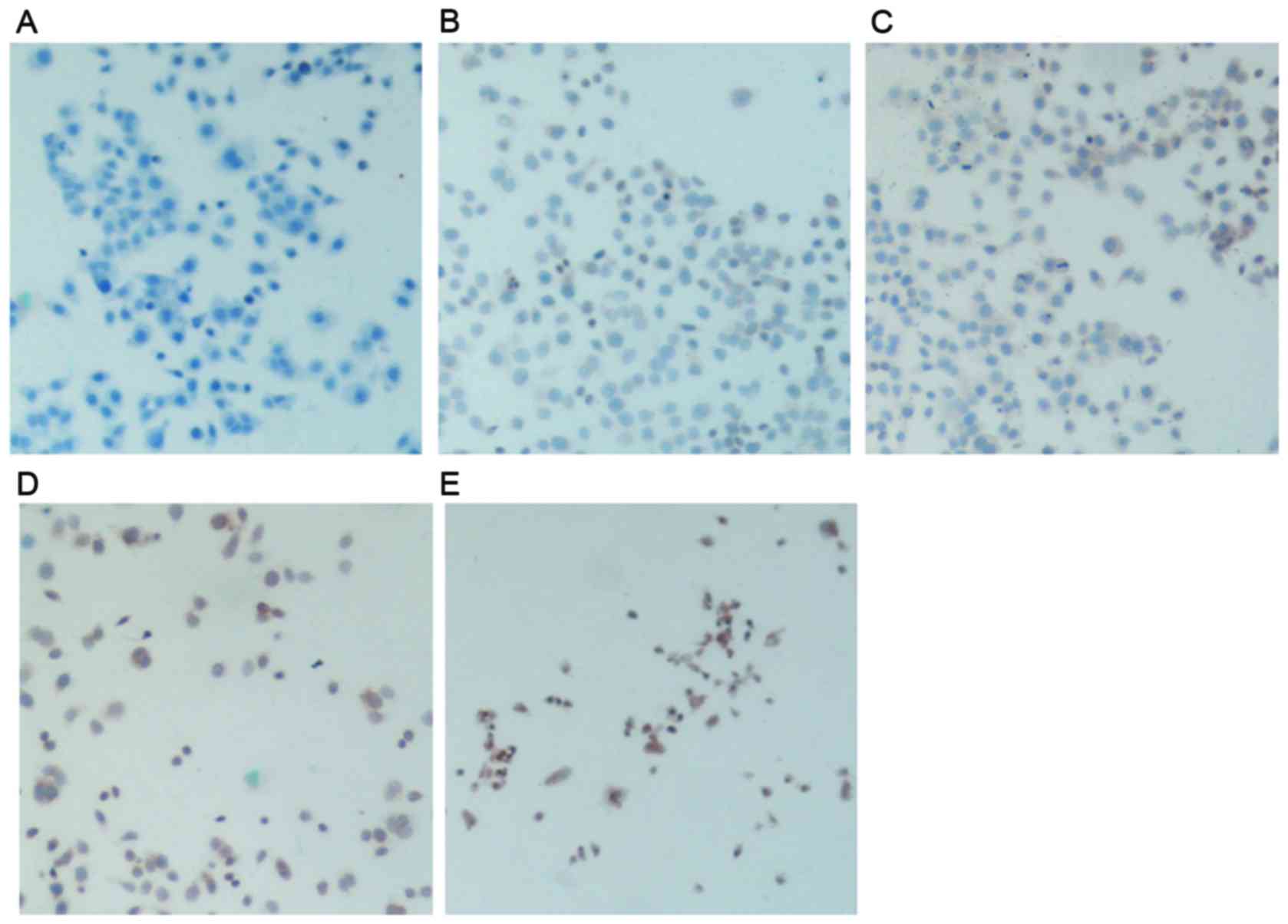An in vitro study on the effects of the combination of salinomycin with cisplatin on human gastric cancer cells
- Authors:
- Published online on: June 8, 2017 https://doi.org/10.3892/mmr.2017.6731
- Pages: 1031-1038
-
Copyright: © Zhang et al. This is an open access article distributed under the terms of Creative Commons Attribution License.
Abstract
Introduction
Gastric carcinoma is one of the most common gastrointestinal malignancies worldwide, and is developed mainly in gastric endothelial tissue. It is characterized by high incidence and mortality rates, and it was the second most common type of cancer in China in 2009, thus posing a serious threat for global health (1). Cisplatin (DDP) has significant anticancer effects on gastric carcinoma; however, its use is limited due to its severe side effects (2). In addition, DDP has been associated with the development of drug resistance, which may result in failure of anticancer treatment (3–5). Therefore, the development of novel therapeutic strategies, as well as novel drug combinations, characterized by high efficiency and low toxicity, is of great clinical significance for the treatment of patients with gastric cancer.
Several polyether ionophores have demonstrated anticancer activity against the proliferation of various cell types, such as leukemia, colon carcinoma and prostate cancer cells, and cancer stem cells, including tumors that exhibit multi-drug resistance (6). Salinomycin (SAL) is a carboxyl polyether, first extracted from Streptomyces albus in 1974 (7). Due to its cation-neutralizing properties it can potently inhibit the growth of most Gram-positive bacteria and various Coccidia (8–10). Gupta et al reported that the inhibitory effects of SAL on breast cancer stem cell proliferation were ~100 times more potent than the chemotherapeutic agent paclitaxel (11). Previous studies have demonstrated that SAL exhibited anticancer effects in various types of cancer and may have potential as a novel anticancer agent (8,12–18).
It has previously been reported that nuclear factor (NF)-κB may be implicated in the development of tumor drug resistance (19), whereas SAL was demonstrated to effectively inhibit the proliferation of cancer stem cells with high drug resistance (20–21). Therefore, it may be hypothesized that SAL can inhibit the activation of NF-κB, and thus increase the susceptibility of gastric cancer cells to DDP. In the present study, the anticancer effects of SAL, DDP and their combination were evaluated in the SGC-7901 gastric cancer cell line. In addition, the mechanisms underlying their actions in the induction of cancer cell apoptosis were investigated.
Materials and methods
Reagents
SAL was purchased from Shunbo Biological Technology and Engineering Co., Ltd. (Shanghai, China). DDP was obtained from Jiangsu Hansoh Pharmaceutical Group Co., Ltd. (Jiangsu, China). MTT solution was purchased from Merck KGaA (Darmstadt, Germany). RPMI-1640 medium was purchased from Thermo Fisher Scientific, Inc. (Waltham, MA, USA). Fetal bovine serum (FBS) was purchased from Hangzhou Sijiqing Biological Engineering Materials Co., Ltd. (Hangzhou, China). Propidium iodide (PI) was purchased from Merck KGaA. Acridine orange (AO) was obtained from Amresco, LLC (Solon, OH, USA). Annexin V-fluorescein isothiocyanate (FITC)/PI apoptosis detection kit was purchased from BD Biosciences (Franklin Lakes, NJ, USA). The rabbit anti-human NF-κB p65 polyclonal antibody (cat. no. A00224) was obtained from GenScript (Nanjing) Co., Ltd. (Nanjing, China). The 3,3′-diaminobenzidine (DAB) color developing kit, rabbit anti-human Fas protein ligand (L) polyclonal antibody (cat. no. BA0049) and biotin-labeled secondary antibody (cat. no. BA1003) were purchased from Wuhan Boster Biological Technology, Ltd. (Wuhan, China).
Cell culture
The SGC-7901 human gastric cancer cell line was purchased from Digestion Research Center of Xi'an Jiaotong University Health Science Center (Xi'an, China). Cells were cultured in RPMI-1640 medium, supplemented with 10% FBS, 100 U/ml penicillin and 100 U/ml streptomycin and maintained in a humidified 5% CO2 atmosphere at 37°C.
MTT assay
SGC-7901 cells at the logarithmic growth phase were seeded in 96-well plates at a density of 1×104 cells/well, and incubated at 37°C overnight to form a monolayer. Cells were divided into the following four groups: SAL group, where cells were treated with 4, 8 and 16 µmol/l SAL (dissolved in ethanol); DDP group, where cells were treated with 6 µmol/l DDP (dissolved in normal saline); combination group, where cells were treated with SAL (4, 8 and 16 µmol/l) and DDP (6 µmol/l); and control group, where cells did not receive drug treatment. Experiments were repeated 5 times for each group. Cells were incubated in a 95% humidified atmosphere at 37°C and 5% CO2 for 24, 48 and 72 h. Following incubation, MTT solution (20 µl) was added and cells were incubated at 37°C for an additional 4 h. Subsequently, the supernatants were removed and the crystals were dissolved with 150 µl DMSO. The absorbance at 490 nm was measured to assess cellular proliferation. Results were averaged from three independent measurements.
Cellular morphology
SGC-7901 cells were seeded in a 6-well plate at a density of 2×105 cells/well. Following incubation for 24 h, drugs were added. The cells were divided into four groups: SAL group (8 µmol/l), DDP group (6 µmol/l), combination group [SAL (8 µmol/l) and DDP (6 µmol/l)] and control group. Following incubation for 48 h, cellular morphology was observed under an inverted phase-contrast microscope (Nikon Corporation, Tokyo, Japan). All experiments were repeated three times.
In another set of experiments, following drug treatment for 48 h as aforementioned, cells were washed twice with PBS and fixed with 75% ice cold ethanol for 2 h at −20°C. Subsequently, PI (50 µg/l) was added and incubated at 4°C for 30 min in the dark; after which, AO (50 µg/ml) was added and incubated at 4°C for 10 min in the dark. Cellular morphology was observed under a fluorescence microscope (Nikon Corporation). All experiments were repeated three times.
Flow cytometry
SGC-7901 cells were seeded in a 6-well plate at a density of 2×105 cells/well. Following incubation for 24 h, fresh medium containing 0.5% FBS was added and cells were cultured for an additional 24 h to synchronize. Cells received treatment with different drugs as aforementioned and were incubated for 48 h. Subsequently, cells were digested with trypsin, collected and fixed with 75% ice-cold ethanol for 2 h at −20°C. The cell suspension was centrifuged at 350 × g for 5 min at room temperature and the supernatant was discarded. Following washing with PBS, cells were incubated with RNase (20 µg/l) at 37°C for 30 min. For cell cycle analysis, cells were fixed with 75% ice-cold ethanol for 2 h at −20°C and were then stained with PI (50 µg/l) for 30 min at 4°C. Cell cycle analysis was performed using a Sysmex CyFlow® Cube 8 flow cytometer (Sysmex Europe GmbH, Norderstedt, Germany) and data were analyzed using FCS Express Application V3 software (De Novo Software, Glendale, CA, US).
To evaluate cellular apoptosis, SGC-7901 cells were prepared as aforementioned in the Cellular morphology subsection. Following drug treatment for 48 h, cells were collected, washed twice with PBS, transferred to Eppendorf tubes and stained with Annexin V-FITC and PI for 10 min at 4°C, according to the manufacturer's protocol. The apoptotic rate was assessed in all experimental groups using a Sysmex CyFlow® Cube 8 flow cytometer (Sysmex Europe GmbH) and data were analyzed using FCS Express Application V3 software (De Novo Software).
Immunocytochemistry
SGC-7901 cells were prepared as aforementioned in the Cellular morphology subsection. Following incubation for 48 h, cells were washed with PBS three times and fixed with 4% paraformaldehyde for 20 min at room temperature. After air-drying, cells were fixed to glass slides using neutral gum and permeabilized with 0.3% Triton X-100 for 15 min at room temperature. Following a wash with PBS, cells were incubated with trypsin at 37°C for 30 min followed by 3% H2O2 for 20 min at 37°C, the cells were then blocked with goat serum (Wuhan Boster Biological Technology, Ltd.) for 30 min at 37°C. Subsequently, cells were incubated with anti-NF-κB p65 (dilution 1:100) and anti-FasL primary antibodies (dilution 1:100) at 4°C overnight. Following a wash with PBS, cells were incubated with biotin-labeled secondary antibodies (dilution 1:500) (cat. no. BA1003; Wuhan Boster Biological Technology, Ltd.) for 2 h at room temperature, and then stained with DAB in the dark for 5 min. The staining was monitored under a microscope and the slides were washed with water to terminate the reaction. Hematoxylin was used for counter-staining at room temperature for 5 min. Hydrochloric acid alcohol (0.1%) was used to differentiate the staining, and sections were dehydrated with alcohol, cleared with xylene and sealed with neutral gum. Photomicrographs were captured with a Nikon E600 microscope (Nikon Corporation, Tokyo, Japan).
Statistical analysis
The statistical significance of the difference between groups was assessed by one-way analysis of variance, followed by a post hoc least significant difference test. All experiments were repeated three times. Data are expressed as the mean ± standard deviation. P<0.05 was considered to indicate a statistically significant difference. The analysis was performed using IBM SPSS software version 22.0 (IBM SPSS, Armonk, NY, USA).
Results
Effects of SAL and DDP on SGC-7901 proliferation
To assess the inhibitory effects of SAL and DDP alone, as well as their combination, on cellular proliferation, the MTT assay was performed. Results revealed that SAL and DDP inhibited the proliferation of SGC-7901 cells, and their inhibitory rate increased with the concentration used and the incubation time (Table I). The combination of SAL (4, 8 and 16 µmol/l) and DDP (6 µmol/l) exerted a significant inhibitory effect on cellular proliferation following 24, 48 and 72 h of incubation, compared with the control, DDP alone and SAL alone groups (P<0.05). These results suggested that SAL may be able to enhance the susceptibility of SGC-7901 cells to DDP.
Alterations in cellular morphology following treatment with SAL and DDP
To assess the effects of SAL and DDP alone, as well as their combination, on cellular morphology, the shapes of SGC-7901 cells were observed following treatment. In the control group, SGC-7901 cells grew adherently, connected closely and tightly, and were characterized by a full cytoplasm and a polygonal or spindle shape (Fig. 1A). Following treatment with SAL or DDP for 48 h, cells appeared to shrink, gaps between cells became larger, cell-cell connections disappeared, nuclear membranes started to shrink and cellular volume decreased (Fig. 1B and C). When the combination of SAL and DDP was applied, cellular volumes appeared to be further reduced compared with the DDP alone and SAL alone groups, and cell numbers also decreased (Fig. 1D).
To determine the effects of SAL or DDP alone, as well as their combination, on SGC-7901 apoptosis, the apoptotic morphology of cells was observed under a fluorescence microscope. SGC-7901 cells in the control group grew well and exhibited homogeneous sizes, regular nuclei, smooth nuclear membranes and evenly-distributed chromatin (Fig. 2). Following treatment with DDP or SAL, cellular morphology appeared altered. Cell numbers were reduced, and DNA appeared condensed and near the nuclear membrane. Apoptotic bodies were formed, and the cellular nuclei became more condensed. The combination of DDP and SAL produced more pronounced morphological alterations on SGC-7901 cells compared with the DDP alone and SAL alone groups (Fig. 2).
Effects of SAL and DDP on SGC-701 cell cycle progression
To determine the effects of SAL or DDP alone, as well as their combination, on cell cycle distribution, flow cytometry was used. Following treatment with DDP or SAL for 48 h, the number of SGC-7901 cells in G0/G1 phase decreased, whereas the number of cells in S phase increased (Fig. 3A-D). SGC-7901 cells in S phase accounted for 33.52 and 34.57% of total cells in the DDP- and SAL-treated groups, respectively, which were significantly different compared with the control group (22.43%; P<0.05). These results suggested that SAL and DDP caused S phase arrest in SGC-7901 cells. The cells in S phase in the SAL and DDP combined treatment group accounted for 57.45% of the population, which was significantly higher compared with the control, DDP alone and SAL alone groups (P<0.05).
SAL and DDP induce cellular apoptosis
To determine the effects of SAL or DDP alone, as well as their combination, on SGC-7901 cell apoptosis, apoptotic cells were detected using flow cytometry. Apoptotic rates of SGC-7901 cells were 9.76 and 14.69% following treatment with DDP and SAL respectively (Fig. 4), and were significantly higher compared with the control group (2.37%; P<0.05). The apoptotic rate of SGC-7901 cells was 27.79% following treatment with the combination of DDP and SAL, which was significantly higher compared with the control, DDP alone and SAL alone groups (P<0.05). These results suggested that SAL and DDP alone, as well as their combination, were able to induce SGC-7901 cell apoptosis, and the combined treatment produced more potent proapoptotic effects.
Effects of SAL and DDP on NF-κB p65 and FasL expression
To investigate the mechanism underlying the proapoptotic effects of SAL and DDP, as well as their combination, immunohistochemistry was performed to assess the expression of NF-κB p65 and FasL following treatment. The present results demonstrated that NF-κB p65 was expressed in control cells, as nuclei were stained dark brown (Fig. 5B). Following treatment with DDP or SAL, NF-κB p65 expression was decreased, as the intensity of nuclear and cytosolic staining appeared reduced (Fig. 5C and D). The combination treatment group had much lower NF-κB p65 expression than those in the control group and the DDP and SAL separate treatment groups. The cell nuclei exhibited decreased brown color and presented some blue color, and part of the cytosol showed light brown color (Fig. 5E).
The expression of FasL in control SGC-7901 cells appeared low, as revealed by the low intensity of brown staining present in the cytosol and cell membrane (Fig. 6B). Following treatment with DDP or SAL, the expression of FasL in the cytosol appeared to be increased, as the intensity of staining increased. SAL-treated gastric cancer cells exhibited higher FasL expression compared with DDP-treated cells, as suggested by the higher intensity of nuclear and cytosolic staining present in SAL-treated cells (Fig. 6C and D). Cells treated with a combination of DDP and SAL exhibited increased FasL staining compared with the control, DDP alone and SAL alone groups, as the intensity of dark brown nuclear and cytosolic staining appeared markedly increased (Fig. 6E).
Discussion
Gastric cancer is one of the most common malignant tumors in the clinical setting. As an ionophore antibiotic, SAL may contribute to the inhibition of tumor cell proliferation. However, it has previously been reported that SAL may exhibit strong neurotoxic effects (22). DDP is a conventional chemotherapy drug used in clinical practice that exhibits significant antitumor effects. However, it has been reported to be prone to induce drug resistance during the treatment of gastric cancer, which may eventually lead to treatment failure (4,5). The results of the present study suggested that SAL may enhance the susceptibility of SCG-7901 gastric cancer cells to DDP, and the mechanism underlying its effects may involve NF-κB p65 downregulation and FasL upregulation.
NF-κB is a nuclear transcription factor that has been implicated in various physiological and pathophysiological processes, such as embryonic development, tissue injury and repair, inflammation, viral infection, tumor development and progression, and in the regulation of apoptosis-related gene expression (23–25). Under physiological conditions, NF-κB remains in the cytosol in the form of inactive p65/p50/inhibitor of κB (IκB-α) complexes, and thus its transcriptional actions are suppressed (26). Following stimulation by cytokines, physical and chemical factors, such as X-rays and chemotherapy drugs, and other activators, IκB-α is phosphorylated and ubiquitinated. As a result, the conformation of the p65/p50/IκB-α complex is altered, allowing NF-κB to translocate into the nucleus and activate the transcription of target genes (27,28). Previous research has suggested that the suppression of NF-κB may enhance apoptosis mediated by the Fas/FasL signaling pathway (29–31). Fas and FasL are a pair of molecules located on cell membranes, which promote apoptosis via the death receptor pathway. Binding of FasL to Fas can initiate death signaling cascades, leading to cancer cell apoptosis (32–34). Chen et al reported that the expression of Fas/FasL genes may be associated with NF-κB (29). Travert et al indicated that NF-κB activation may indirectly inhibit Fas, tumor necrosis factor (TNF) receptor 1 and TNF-related apoptosis-inducing ligand, to ultimately promote cellular apoptosis (30). Therefore, since NF-κB and FasL may serve a role in the promotion of tumor cell apoptosis (35–39), the present study investigated the implication of NF-κB and FasL in the mechanisms underlying the proapoptotic actions of SAL.
SAL has previously been reported to inhibit the proliferation of breast cancer stem-like cells via an apoptosis-independent pathway (40). Zhi et al demonstrated that SAL selectively inhibited the proliferation of gastric cancer cells characterized by high aldehyde dehydrogenase activity, which are resistant to 5-fluorouracil and DDP (21). In the present study, SAL was demonstrated to inhibit the proliferation of gastric cancer cells in a dose- and time-dependent manner. These results are in accordance with the study by Zhi et al (21), as they demonstrated the cytotoxic effects of SAL on gastric cancer cells. Furthermore, the present study suggested that the combination of SAL and DDP may possess more potent cytotoxic potential compared with treatment with SAL or DDP alone. The addition of SAL appeared to enhance the susceptibility of gastric cancer cells to DDP. Treatment with SAL or DDP alone, as well as their combination, was revealed to alter cellular morphology, and combined treatment exhibited stronger effects compared with separate treatments. PI and AO staining, and flow cytometry demonstrated that the apoptotic rate of cells treated with the combination of SAL and DDP was markedly higher compared with the control, DDP alone and SAL alone groups. These results suggested that SAL and DDP may be able to synergistically induce gastric cancer cell apoptosis. These results are consistent with the study by Liu et al, which reported that SAL alone and in combination with vincristine induced apoptosis of Jurkat cancer cells (41).
The present study demonstrated that SAL alone and in combination with DDP could alter cell cycle distribution and prolong the S phase, and combined treatment exhibited stronger effects compared with treatment with SAL or DDP alone. These results suggested that the mechanisms underlying the inhibitory effects of SAL and DDP may involve interference in DNA synthesis and replication in cancer cells. Immunocytochemistry was used to further investigate the mechanisms underlying the proapoptotic actions of SAL and DDP. The present results revealed that SAL and DDP inhibited the translocation of NF-κB p65 into the nuclei of cancer cells. The combination of SAL and DDP markedly downregulated the expression of NF-κB p65 and upregulated the expression of FasL. These results suggested that SAL and DDP may induce cancer cell apoptosis via inhibiting the activation of NF-κB p65 and promoting the activation of Fas/FasL pathways, consistent with previous findings (29–31). Combination of the drugs enhanced the proapoptotic actions of DDP on SGC-7901 cells. In accordance with the present results, Parajuli et al reported that SAL inhibited the nuclear translocation of NF-κB (42).
In conclusion, the present study demonstrated that the novel anticancer agent SAL inhibited gastric cancer cell proliferation, alone or in combination with DDP, and induced cellular apoptosis. The present results suggested that the mechanisms underlying its actions may involve upregulation of FasL and downregulation of NF-κB p65 expression.
Acknowledgements
The present study was supported by the National Science Foundation (grant no. 81470140) and the Health Science and research project of Shaanxi Province (grant no. 2014D31).
References
|
Chen W, Zhang R, Zhang S, Zhao P, Li G, Wu L and He J: Report of incidence and mortality in China cancer registries, 2009. Chin J Cancer Res. 25:10–21. 2013.PubMed/NCBI | |
|
Lenz HJ, Lee FC, Haller DG, Singh D, Benson AB III, Strumberg D, Yanagihara R, Yao JC, Phan AT and Ajani JA: Extended safety and efficacy data on S-1 plus cisplatin in patients with untreated, advanced gastric carcinoma in a multicenter phase II study. Cancer. 109:33–40. 2007. View Article : Google Scholar : PubMed/NCBI | |
|
Li G, Yang F, Gu S, Li Z and Xue M: MicroRNA-101 induces apoptosis in cisplatin-resistant gastric cancer cells by targeting VEGF-C. Mol Med Rep. 13:572–578. 2016.PubMed/NCBI | |
|
Chen DD, Feng LC, Ye R, He YQ and Wang YD: miR-29b reduces cisplatin resistance of gastric cancer cell by targeting PI3K/Akt pathway. Zhongguo Yi Xue Ke Xue Yuan Xue Bao. 37:514–519. 2015.(In Chinese). PubMed/NCBI | |
|
Zhou X, Jin W, Jia H, Yan J and Zhang G: MiR-223 promotes the cisplatin resistance of human gastric cancer cells via regulating cell cycle by targeting FBXW7. J Exp Clin Cancer Res. 34:282015. View Article : Google Scholar : PubMed/NCBI | |
|
Huczyński A: Polyether ionophores-promising bioactive molecules for cancer therapy. Bioorg Med Chem Lett. 22:7002–7010. 2012. View Article : Google Scholar : PubMed/NCBI | |
|
Miyazaki Y, Shibuya M, Sugawara H, Kawaguchi O and Hirsoe C: Salinomycin, a new polyether antibiotic. J Antibiot (Tokyo). 27:814–821. 1974. View Article : Google Scholar : PubMed/NCBI | |
|
Daugschies A, Gässlein U and Rommel M: Comparative efficacy of anticoccidials under the conditions of commercial broiler production and in battery trials. Vet Parasitol. 76:163–171. 1998. View Article : Google Scholar : PubMed/NCBI | |
|
Danforth HD, Ruff MD, Reid WM and Miller RL: Anticoccidial activity of salinomycin in battery raised broiler chickens. Poult Sci. 56:926–932. 1977. View Article : Google Scholar : PubMed/NCBI | |
|
Mahmoudi N, de Julián-Ortiz JV, Ciceron L, Gálvez J, Mazier D, Danis M, Derouin F and García-Domenech R: Identification of new antimalarial drugs by linear discriminant analysis and topological virtual screening. J Antimicrob Chemother. 57:489–497. 2006. View Article : Google Scholar : PubMed/NCBI | |
|
Gupta PB, Onder TT, Jiang G, Tao K, Kuperwasser C, Weinberg RA and Lander ES: Identification of selective inhibitors of cancer stem cells by high-throughput screening. Cell. 138:645–659. 2009. View Article : Google Scholar : PubMed/NCBI | |
|
Naujokat C, Fuchs D and Opelz G: Salinomycin in cancer: A new mission for an old agent. Mol Med Rep. 3:555–559. 2010. View Article : Google Scholar : PubMed/NCBI | |
|
Kopp F, Hermawan A, Oak PS, Ulaganathan VK, Herrmann A, Elnikhely N, Thakur C, Xiao Z, Knyazev P, Ataseven B, et al: Sequential salinomycin treatment results in resistance formation through clonal selection of epithelial-like tumor cells. Transl Oncol. 7:702–711. 2014. View Article : Google Scholar : PubMed/NCBI | |
|
Kim JH, Chae M, Kim WK, Kim YJ, Kang HS, Kim HS and Yoon S: Salinomycin sensitizes cancer cells to the effects of doxorubicin and etoposide treatment by increasing DNA damage and reducing p21 protein. Br J Pharmacol. 162:773–784. 2011. View Article : Google Scholar : PubMed/NCBI | |
|
Xiao Z, Sperl B, Ullrich A and Knyazev P: Metformin and salinomycin as the best combination for the eradication of NSCLC monolayer cellsand their alveospheres (cancer stem cells) irrespective of EGFR, KRAS, EML4/ALK and LKB1 status. Oncotarget. 5:12877–12890. 2014. View Article : Google Scholar : PubMed/NCBI | |
|
Antoszczak M, Popiel K, Stefańska J, Wietrzyk J, Maj E, Janczak J, Michalska G, Brzezinski B and Huczyński A: Synthesis, cytotoxicity and antibacterial activity of new esters of polyether antibiotic - salinomycin. Eur J Med Chem. 76:435–444. 2014. View Article : Google Scholar : PubMed/NCBI | |
|
Kopp F, Hermawan A, Oak PS, Herrmann A, Wagner E and Roidl A: Salinomycin treatment reduces metastatic tumor burden by hampering cancer cell migration. Mol Cancer. 13:162014. View Article : Google Scholar : PubMed/NCBI | |
|
Huczynski A: Salinomycin: A new cancer drug candidate. Chem Biol Drug Des. 79:235–238. 2012. View Article : Google Scholar : PubMed/NCBI | |
|
Moretti M, Bennett J, Tornatore L, Thotakura AK and Franzoso G: Cancer: NF-κB regulates energy metabolism. Int J Biochem Cell Biol. 44:2238–2243. 2012. View Article : Google Scholar : PubMed/NCBI | |
|
Ni M, Xiong M, Zhang X, Cai G, Chen H, Zeng Q and Yu Z: Poly (lactic-co-glycolic acid) nanoparticles conjugated with CD133 aptamers for targeted salinomycin delivery to CD133+ osteosarcoma cancer stem cells. Int J Nanomedicine. 10:2537–2554. 2015.PubMed/NCBI | |
|
Zhi QM, Chen XH, Ji J, Zhang JN, Li JF, Cai Q, Liu BY, Gu QL, Zhu ZG and Yu YY: Salinomycin can effectively kill ALDH (high) stem-like cells on gastric cancer. Biomed Pharmacother. 65:509–515. 2011. View Article : Google Scholar : PubMed/NCBI | |
|
Song SP, Zhang XG, Wang M, et al: Change and significance of serum creatine kinase and its isoenzyme in salinomycin poisoning patients. Zhong Guo Wei Sheng Jian Yan Za Zhi. 21:28–29. 2011. | |
|
Cai Z, Tchou-wong KM and Rom WN: NF-kappaB in lung tumorigenesis. Cancers (Basel). 3:4258–4268. 2011. View Article : Google Scholar : PubMed/NCBI | |
|
Hayden MS and Ghosh S: Shared principles in NF-kappaB signaling. Cell. 132:344–362. 2008. View Article : Google Scholar : PubMed/NCBI | |
|
Varfolomeev E, Goncharov T, Maecker H, Zobel K, Kömüves LG, Deshayes K and Vucic D: Cellular inhibitors of apoptosis are global regulators of NF-κB and MAPK activation by members of the TNF family of receptors. Sic Signal. 5:ra222012. | |
|
Majdalawieh A and Ro HS: Regulation of IkappaBalpha function and NF-kappaB signaling: AEBP1 is a novel proinflammatory mediator in macrophages. Mediators Inflamm. 2010:8238212010. View Article : Google Scholar : PubMed/NCBI | |
|
Lee HJ, Seo HS, Kim GJ, Jeon CY, Park JH, Jang BH, Park SJ, Shin YC and Ko SG: Houttuynia cordata Thunb inhibits the production of pro-inflammatory cytokines through inhibition of the NFκB signaling pathway in HMC-1 human mast cells. Mol Med Rep. 8:731–736. 2013.PubMed/NCBI | |
|
Ferreiro DU and Komives EA: Molecular mechanisms of system control of NF-kappaB signaling by IkappaBalpha. Biochemistry. 49:1560–1567. 2010. View Article : Google Scholar : PubMed/NCBI | |
|
Chen S, Dong Y, Xu C, Jiang L, Chen Y, Jiang C, Hou W and Li W: Involvement of a chromatin modifier in response to mono-(2-ethylhexyl) phthalate (MEHP)-induced Sertoli cell injury: Probably an indirect action via the regulation of NF-κB/FasL circuitry. Biochem Biophys Res Commun. 440:749–755. 2013. View Article : Google Scholar : PubMed/NCBI | |
|
Travert M, Ame-Thomas P, Pangault C, Morizot A, Micheau O, Semana G, Lamy T, Fest T, Tarte K and Guillaudeux T: CD40 ligand protects from TRAIL-induced apoptosis in follicular lymphomas through NF-kappaB activation and up-regulation of c-FLIP and Bcl-xL. J Immunol. 181:1001–1111. 2008. View Article : Google Scholar : PubMed/NCBI | |
|
Wang L, Zhao S, Wang HX and Zou P: Inhibition of NF-kappa B can enhance Fas-mediated apoptosis in leukemia cell line HL-60. Front Med China. 4:323–328. 2010. View Article : Google Scholar : PubMed/NCBI | |
|
Strasser A, Jost PJ and Nagata S: The many roles of FAS receptor sig-naling in the immune system. Immunity. 30:180–192. 2009. View Article : Google Scholar : PubMed/NCBI | |
|
Mahmood Z and Shukla Y: Death receptors: Targets for cancer therapy. Exp Cell Res. 316:887–899. 2010. View Article : Google Scholar : PubMed/NCBI | |
|
Chen L, Park SM, Tumanov AV, Hau A, Sawada K, Feig C, Turner JR, Fu YX, Romero IL, Lengyel E and Peter ME: CD95 promotes tumour growth. Nature. 465:492–496. 2010. View Article : Google Scholar : PubMed/NCBI | |
|
Kong FC, Zhang JQ, Zeng C, Chen WL, Ren WX, Yan GX, Wang HX, Li QB and Chen ZC: Inhibitory effects of parthenolide on the activity of NF-κB in multiple myeloma via targeting TRAF6. J Huazhong Univ Sci Technolog Med Sci. 35:343–349. 2015. View Article : Google Scholar : PubMed/NCBI | |
|
Diab S, Fidanzi C, Léger DY, Ghezali L, Millot M, Martin F, Azar R, Esseily F, Saab A, Sol V, et al: Berberis libanotica extract targets NF-κB/COX-2, PI3K/Akt and mitochondrial/caspase signalling to induce human erythroleukemia cell apoptosis. Int J Oncol. 47:220–230. 2015.PubMed/NCBI | |
|
Gmeiner WH, Jennings-Gee J, Stuart CH and Pardee TS: Thymineless death in F10-treated AML cells occurs via lipid raft depletion andFas/FasL co-localization in the plasma membrane with activation of the extrinsic apoptotic pathway. Leuk Res. 39:229–235. 2015. View Article : Google Scholar : PubMed/NCBI | |
|
Liu W, Lin YT, Yan XL, Ding YL, Wu YL, Chen WN and Lin X: Hepatitis B virus core protein inhibits Fas-mediated apoptosis of hepatoma cells via regulation of mFas/FasL and sFas expression. FASEB J. 29:1113–1123. 2015. View Article : Google Scholar : PubMed/NCBI | |
|
Li L, Yao YC, Fang SH, Ma CQ, Cen Y, Xu ZM, Dai ZY, Li C, Li S, Zhang T, et al: Pigment epithelial-derived factor (PEDF)-triggered lung cancer cell apoptosis relies on p53 protein-driven Fas ligand (Fas-L) up-regulation and Fas protein cell surface translocation. J Biol Chem. 289:30785–30799. 2014. View Article : Google Scholar : PubMed/NCBI | |
|
An H, Kim JY, Lee N, Cho Y, Oh E and Seo JH: Salinomycin possesses anti-tumor activity and inhibits breast cancer stem-like cells via an apoptosis-independent pathway. Biochem Biophys Res Commun. 466:696–703. 2015. View Article : Google Scholar : PubMed/NCBI | |
|
Liu PP, Zhu JC, Liu GX, Shui CX and Li XM: Salinomycin enhances the apoptosis of T-cell acute lymphoblastic leukemia cell line jurkat cells induced by vincristine. Zhongguo Shi Yan Xue Ye Xue Za Zhi. 23:653–657. 2015.(In Chinese). PubMed/NCBI | |
|
Parajuli B, Shin SJ, Kwon SH, Cha SD, Chung R, Park WJ, Lee HG and Cho CH: Salinomycin induces apoptosis via death receptor-5 up-regulation in cisplatin-resistant ovarian cancer cells. Anticancer Res. 33:1457–1462. 2013.PubMed/NCBI |



